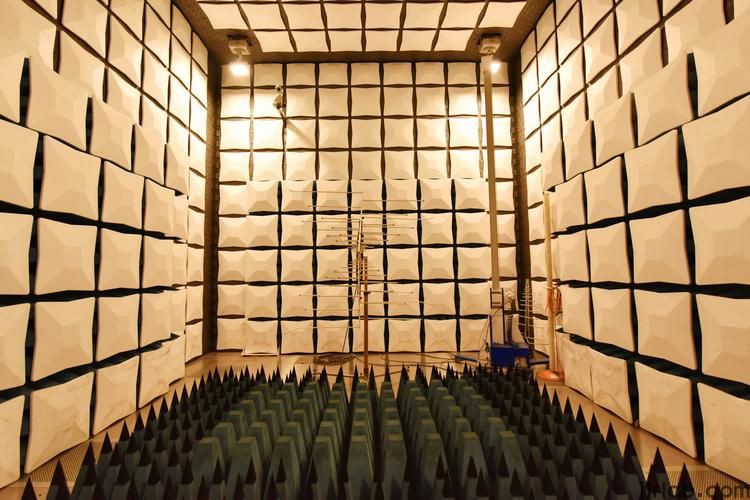
EMI Emissions Testing
Radiated emissions testing measures the radiated disturbance field strength emitted by the EUT (Equipment Under Test) through space. It can be divided into:
- Magnetic Field Radiation: Mainly used for lighting devices and induction cookers;
- Electric Field Radiation: More widely applied;
- Disturbance Power: Suitable for household appliances, power tools, and AV product auxiliary devices.

1. Radiated Emissions Testing Standards
a) Electric Field Radiation Standards:
- CISPR22
- CISPR13
- CISPR11
- CISPR14-1
- CISPR15 (for specific types of toys)
b) Magnetic Field Radiation Standards:
- CISPR15 (for lamps with operating current frequencies >100Hz)
- CISPR11 (for induction cookers)
c) Disturbance Power Standards:
- CISPR14-1 (excluding devices with operating frequencies ≤9kHz)
- CISPR13 (only for auxiliary devices)
2. Radiated Emissions Testing Methods
1. Test Instruments and Equipment:
a) Electric Field Radiation:
- Receiver (for frequencies below 1GHz)
- Spectrum analyzer (for frequencies above 1GHz)
- Anechoic chamber
- Antennas:
- Below 1GHz: Biconical antenna + Log-periodic antenna / Broadband composite antenna
- Above 1GHz: Horn antenna
b) Magnetic Field Radiation:
- Receiver
- Tri-axis loop antenna / Single small loop far-field antenna
c) Disturbance Power:
- Receiver
- Power absorption clamp
Standards Requirements:
- Receiver: CISPR16-1-1
- Antennas and Site: CISPR16-1-4
- Absorption Clamp: CISPR16-1-3
2. Test Setup:
a) Electric Field Radiation:
- Differentiate between desktop and floor-standing devices;
- Similar to conducted emissions setup;
- All devices and cables must be arranged strictly according to the standards;
b) Magnetic Field Radiation:
- Tri-axis loop antenna: For EUTs with lengths <1.6m (antenna diameter 2m);
- For induction cookers longer than 1.6m: Use a 0.6m diameter single loop far-field antenna at a distance of 3m, with a minimum height of 1m (CISPR11);
c) Disturbance Power:
- Desktop: Place on a non-metallic tabletop at a height of 0.8m, with a distance of ≥0.8m from metallic objects (or ≥0.4m, CISPR14-1);
- Floor-standing: Place on a non-metallic stand at a height of 0.1m;
- Test cables (LUT):
- Place on an absorption clamp rail 0.8m high and 6m long;
- Absorption clamp shoULd be on the cable, with the current transformer end facing the EUT;
- Cables that can be disconnected should be broken; non-disconnectable cables should be isolated with ferrite clamps.
3. Test Frequency Range:
- Electric Field Radiation: 30MHz–1GHz (some standards require >1GHz)
- Magnetic Field Radiation: 9kHz–30MHz
- Disturbance Power: 30–300MHz
4. Test Limits:
- Test distance may vary depending on the standard: 3m, 10m, or other distances;
- Limits are related to product categories (Group 1/2, Class A/B).
5. Testing Process:
a) 30MHz–1GHz Electric Field Radiation:
- Semi-anechoic chamber;
- EUT rotates 360° on a turntable;
- Antenna height 1–4m, vertical and horizontal scanning to find the maximum value;
- Use QP (quasi-peak) detector;
- Test both vertical and horizontal polarization directions.
b) >1GHz Electric Field Radiation:
- Applicable to:
- ITE devices: Operating frequency >108MHz;
- ISM devices: Operating frequency >400MHz;
- Test site: 3m;
- Use spectrum analyzer, with results based on Peak and Average values;
- ITE method is similar to the 30MHz–1GHz range;
- ISM devices:
- Test in a full-anechoic chamber;
- Antenna height fixed at the same level as the EUT;
- Antenna does not move, while EUT rotates to find the maximum value.
c) Alternative Method (ERP Calculation):
- Used for testing the radiation of the enclosure;
- Remove detachable cables; for non-detachable cables, use ferrite clamps for isolation;
- Steps:
1. Measure maximum value with Antenna A and receiver;
2. Replace EUT with Antenna B, connect signal source, and adjust to the same output;
3. Record the input power of Antenna B, which is the enclosure radiation power.
d) Magnetic Field Radiation:
- Tri-axis loop antenna: Place the test sample at the center of the antenna;
- Measure X/Y/Z directions;
- Single small loop antenna: Place it vertically on the ground, at a minimum height of 1m;
- Measure the horizontal and vertical magnetic field components of the EUT.
e) Disturbance Power:
- All cables (>25cm) must be tested;
- Disturbance appears as standing wave distribution in the 30–300MHz range;
- Move the absorption clamp during testing to find the maximum value (typically at the half-wavelength position).
3. Test Results Evaluation
- Below limit line: PASS
- Exceeds limit line: FAIL
4. Test Considerations
- The test setup is critical;
- High-frequency testing has high requirements for the site and equipment, which significantly impact results.
5. Test Frequency Range Summary
30MHz – 18.5GHz
JJR Laboratory, China, provides testing services. Feel free to contact us for inquiries.
Email:hello@jjrlab.com
Write your message here and send it to us
 What Are the Testing Items of California Propositi
What Are the Testing Items of California Propositi
 E-Cigarette EU TPD Testing
E-Cigarette EU TPD Testing
 Testing Certification for E-cigarettes Exported to
Testing Certification for E-cigarettes Exported to
 What is Amazon US CPC Certification?
What is Amazon US CPC Certification?
 UK Toy Safety Regulation Standard EN 71-13
UK Toy Safety Regulation Standard EN 71-13
 What is EU UFI Registration?
What is EU UFI Registration?
 EU UFI Registration for E-cigarette E-liquid
EU UFI Registration for E-cigarette E-liquid
 How to get the MSDS Report for Electronic Cigarett
How to get the MSDS Report for Electronic Cigarett
Leave us a message
24-hour online customer service at any time to respond, so that you worry!




